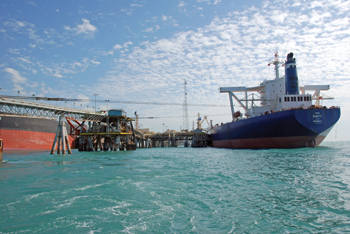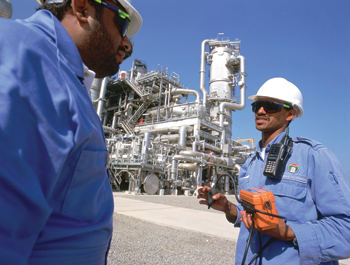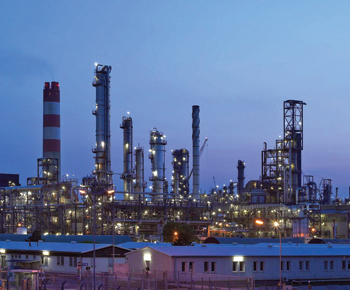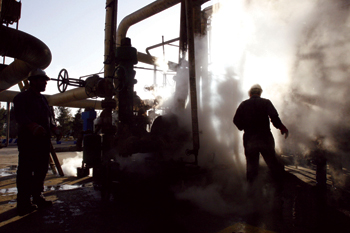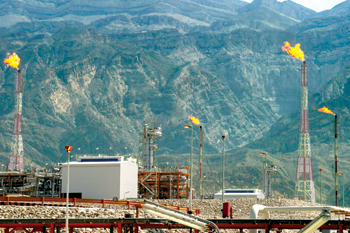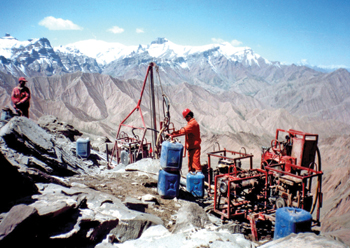
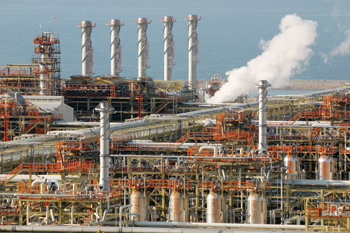 South Pars ... vigorous development in progress
South Pars ... vigorous development in progress
IRAN has put in place an ambitious plan to ramp up its crude oil production to reach 5 million barrels per day (mbpd) by 2018. To achieve this, the country plans to work alongside international oil companies (IOCs) and implement favourable contractual models to encourage foreign investment in the country, says Ali Majedi, deputy petroleum minister for International Affairs and Commerce, Ministry of Petroleum, Iran.
The minister says that $255 billion investment is needed in Iran’s oil and gas sector for it to reach its full potential. Some $155 billion of that investment is earmarked for the upstream sector. He says 55 per cent of the $155 billion should be allocated towards the establishment and enhancement of the production and development of oil and gas fields.
“The strategic position of Iran, with its access across the region north to south, access to water, common borders with 15 countries and developed infrastructure for oil and gas transmission has distinguished the country in the region,” says Majedi.
“Further investment in the oil and gas industry of Iran is attractive, it has high profitability of projects, lower level of risk, professional human capital, security of equipment and of installations, and extra opportunities of development, production and trade of both oil and gas.”
Meanwhile, Iran invested some $7 billion in major oil and gas projects in the current year, which started on March 21, National Iranian Oil Company’s (NIOC) director for Planning Affairs Abdolhamid Delparish says.
“The country plans to invest same amount in oil and gas projects next year,” he says adding that Iran will put the focus on completing under way projects that are 99 per cent complete. NIOC had introduced 41 projects, valued at $100 billion, to foreign investors at the 21st World Petroleum Congress.
The projects involve the development of oil and gas fields, establishment of natural gas liquid (NGL) plants and the collection of associated petroleum gas at oilfields.
Associated petroleum gas is a form of natural gas found with deposits of petroleum. Due to the remote location of many oilfields, in the past, this gas was simply burnt off in gas flares.
The gas can be utilised in a number of ways after processing. It can be sold and included in the natural gas distribution networks, used for on-site electricity generation with engines or turbines, re-injected for enhanced oil recovery, or used as feedstock for the petrochemical industry. Iran needs to daily inject 180 million cubic metres of gas to its oil wells.
Iran has tried to bring on board foreign investors into its energy sector since securing limited sanctions relief from a November interim agreement to temporarily curb its nuclear activities.
Iranian Oil Minister Bijan Namdar Zanganeh says Iran’s oil industry would march forward, with or without sanctions.
“The sanctions have not hindered the trend of progress of Iran’s oil industry,” he says, adding that the new model of contracts would help the country circumvent the sanctions.
Iran, under the terms of the previous buyback contracts, paid contractors a set price for oil and natural gas. Under the planned new system, state-run energy companies will establish joint ventures with their international counterparts, which will be paid with a share of the output.
He says that Iran is in dire need of money and financial resources and can’t afford paying the expenses of giant projects in the energy sector, so it needs the money of domestic and foreign private companies to carry out the projects.
Iran has the world’s fourth-largest proved national reserves of oil – most of it cheap to produce – and is home to the biggest proved reserves of natural gas, some 18 per cent of the global total.
 |
Zanganeh ... oil ministry in over-drive |
According to BP’s latest yearly report, Iran’s dried gas output is about 160 billion cubic metres (bcm), a little more than domestic consumption level.
On the gas production front, Iran plans to increase its production 1.4 bcm of natural gas per day, NIOC’s director for exploration affairs, Hormoz Felavand, says.
“If the country reaches and keeps the mentioned amounts, and in case of no new discovery, Iran’s oil and gas reserves would last for 70 years,” he explains.
“The oil reserves of most countries except for Iran and Saudi Arabia would be finished by then,” Felavand adds.
The country holds the world’s third-largest proven oil reserves and the largest natural gas reserves.
The country’s total in-place oil reserves have been estimated at more than 560 billion barrels, with about 140 billion barrels of extractable oil. Moreover, heavy and extra heavy varieties of crude oil account for roughly 70-100 billion barrels of the total reserves. Iran’s gas reserves have been estimated at 33.6 trillion cubic metres.
Meanwhile, Iran will raise gas condensate processing capacity by establishing eight small refineries, Iran’s oil minister says. The Oil Ministry intends to establish eight refineries in the southern Bushehr province, each with a production capacity of 60, 000 barrels per day Zanganeh says, adding that “by launching the refineries and completing the construction of the Persian Gulf Star Refinery, Iran will be also able to turn one million barrels of gas liquids into value-added products domestically.”
He says the Oil Ministry intends to use the resources of National Development Fund (NDF) to complete major oil projects, but “currently, there are restrictions on using NDF resources such as lack of easy access to funds.” Therefore, private sector can play significant role in achieving the target, Zanganeh says.
Iran plans to utilise the biggest phase of the South Pars gas field, namely the phase 12, before winter to prevent gas shortage in the country during the cold season.
The phase 12 will come on stream by the end of the eighth Iranian calendar month of Aban (November 21), the project manager Rasoul Fallahnejad says.
Once the phase 12 comes on stream, it will inject about 75 million cubic metres (mcm) of gas into the national gas network per day, Fallahnejad says.
Iran is currently producing 300 mcm per day of gas from the South Pars.
The South Pars or North Dome field is a natural gas condensate field located in the Gulf. It is one of the world’s largest gas fields, shared between Iran and Qatar. According to the International Energy Agency (IEA), the field holds an estimated 1,800 trillion cubic feet (51 trillion cubic metres) of in-situ natural gas and some 50 billion barrels (7.9 bcm) of natural gas condensates. This gas field covers an area of 9,700 sq km, of which 3,700 sq km is in Iranian territorial waters called the South Pars and 6,000 sq km is in Qatari territorial waters referred to as the North Dome.
Although Iran possesses one of the world’s largest gas reserves, it has struggled for years to develop its oil and gas resources due to the withdrawal of foreign investors from its energy sector under Western pressure.
 |
Iran’s upstream oil and gas projects are worth $30 billion |
Zanganeh has promised the country’s president to increase Iran’s total gas production by 80-100 million cubic metres per day. The country can reach the goal by launching new phases of giant South Pars gas field.
Zanganeh says that Iran’s total gas output will surpass 4 million cubic metres per day by the end of the current Iranian calendar year (March 20, 2015). Iran also plans to increase its gas exports in near future. Zanganeh says that the country plans to export gas to Europe via pipeline or in the form of LNG (liquid natural gas).
“Europeans prefer to diversify their gas and energy sources.Europeans started negotiations to import Iranian gas nine years ago. But apparently the talks were halted in the previous years,” he explains.
Zanganeh says that Iran is a country capable of exporting large volumes of gas and is always willing to provide gas to Europe. “Once the phases of South Pars gas field come on stream in next (Iranian calendar) year (to start on March 1, 2015), Iran will have extra gas to export,” he says.
Zanganeh says Iran plans to export 80 bcm of gas to Asia and Europe in calendar year 1400 (March 2021-March 2022).
“We are planning to export 80 bcm of gas to Turkey, Europe, Iraq, Pakistan, and the Gulf Arab states in calendar year 1400,” he says. “We should boost oil, gas, electricity, and petrochemicals through diversifying methods of sale and cooperating with the private sector,” he says, adding that the country’s oil refining capacity is projected to rise to 3 mbpd.
Zanganeh says Iran forecasts an increase in its crude oil and natural gas production in the current Iranian calendar year 1393, which began on March 21. With 18 per cent and 9.4 per cent of the world’s total proven gas and oil resources respectively, Iran ranks as the largest in gas and fourth in oil reserve holdings among all nations.
But inefficient projects, huge domestic consumption and lack of technology and finance as well as imposed sanctions aimed at curbing its disputed nuclear programme have diminished Iran’s role in energy markets. According to the latest estimates released by the International Energy Agency, Iran’s November total crude oil and gas condensate export was 850 thousand barrels per day. The figure was 2.5 mbpd in 2011.
Iran’s oil output decreased from 3.628 mbpd in 2011 to 2.7 mbpd, but there is not any concrete information on Iran’s current oil production capacity.
Iran has shut down some oil fields due to a decline in oil exports, while the domestic refining capacity decreased during 2012 to 1.68 last years. On the other hand, most of Iran’s active fields are in their second half-life and their productivity decreases by 8-13 per cent annually, making it quite difficult to distinguish the exact share of closed down wells and the high natural decline rate in oil output cut.
Iran’s oil recovery rate is around 20 to 30 per cent, the US Energy Information Administration says.
Iran announced that the oil recovery rate increased to an average of 29 per cent. But after some critical reports published in Iranian media outlets raised doubts, Abdol-Mohammad Delparish manager of Integrated Planning in National Iranian Oil Company (NIOC) says that the recovery rates of liquid hydrocarbons, crude oil and gas are 29 per cent, 25 per cent and 70 per cent respectively on average.
According to Fourth and Fifth Development Plans (2005-2009 and 2010-2015) Iran should increase the oil recovery rate by 1 per cent during the period of each plan, but the recovery rate remained unchanged during the Fourth Plan. The former head of NIOC, Ahmad Qalebani said in 2012 that Iran needed a $79.094 billion investment to reach a one per cent increase in the crude oil recovery rate.
However, Ex-President Mahmoud Ahmadinejad’s government announced that during 2011 and 2012 the crude oil recovery increased by 0.28 per cent, which raised the doubts about the credibility of the claim again.
During this period, the total of investment put in Iran’s both upstream oil and gas projects was roughly about $30 billion, so reaching a 0.28 per cent crude oil recovery rate growth was impossible.
On the other hand, Iran needed to inject 200 mcm of gas into old oil fields to boost the output, but Iran injected only 70 mcm into fields in the Iranian calendar which ended on March 2012 due to a gas shortage.
During the last two years, Iran’s domestic gas consumption increased, while production level increased as well, then the injected gas volume into oil fields has not experienced increase.
On the consumption issue, Opec’s annual report released on July 29 based on direct communications says that Iran’s oil refining capacity decreased from 1.772 mbpd in 2011 to 1.681 mbpd in 2012.
During 2013, some new plants were inaugurated officially at the Arak and Bandar Abbas refineries, while some plants shut down for months due to damages, including explosions.
However, based on National Iranian Oil Refining & Distribution Company’s statistics, during the last 8 months of the current Iranian solar year (March 20 to November 20), the country’s gasoline consumption increased by 7.5 per cent to 70 million litres per day, oil-gas consumption increased by 8 per cent to 100-105 million litres per day, while kerosene consumption experienced a 12 per cent drop to 8 million litres per day.



































































